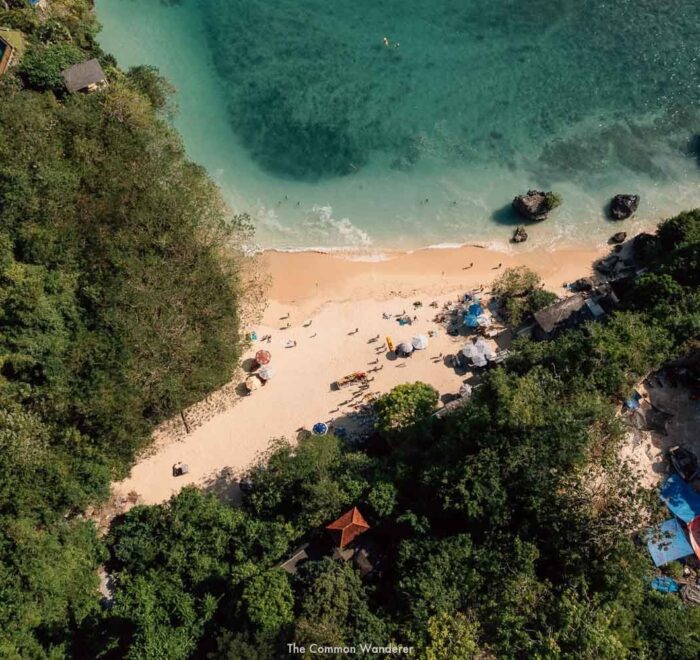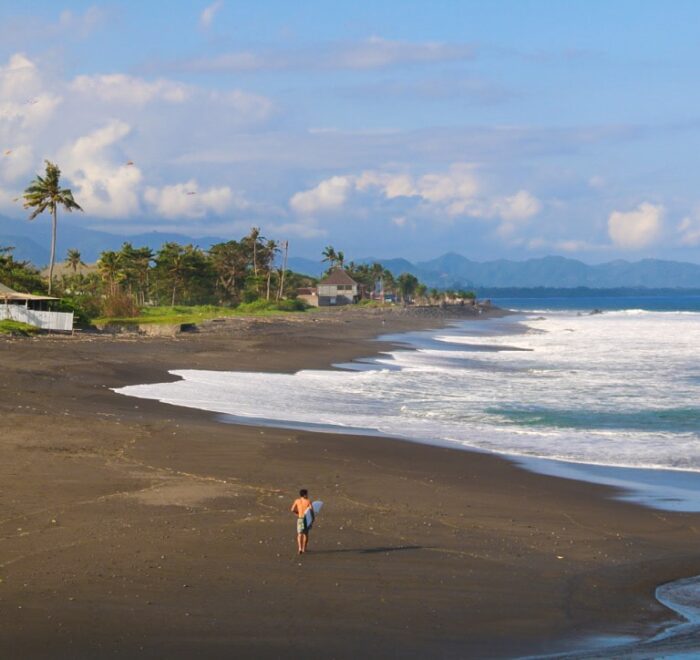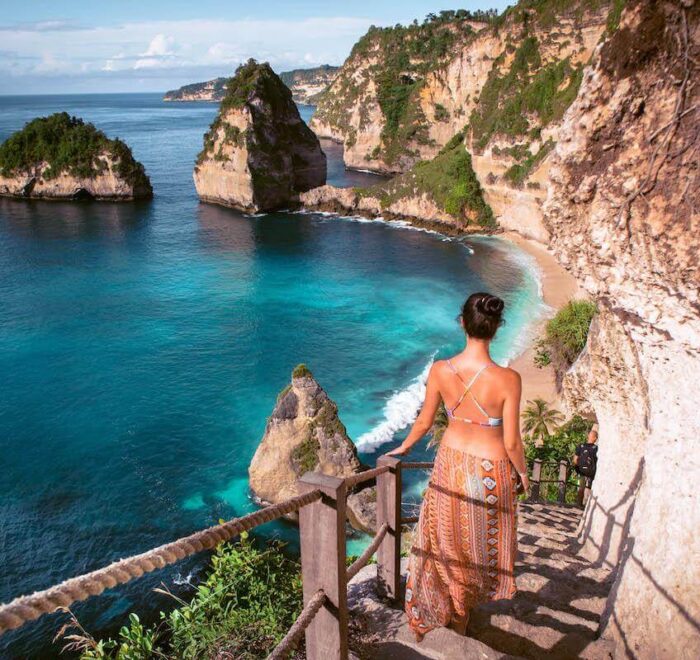Uluwatu Temple is famous for its stunning clifftop location and spiritual significance in Bali. Learn why this temple is a must-see and how to make the most of your visit.
Key Takeaways
- Uluwatu Temple, perched atop a 70-metre-high cliff on Bali’s southwestern tip, offers breathtaking ocean views and holds profound spiritual significance for the Balinese people.
- Visitors to Uluwatu Temple should be aware of entrance fees, opening hours, dress codes, and visitor etiquette to ensure respectful and harmonious visits.
- The evening Kecak Dance performance, depicting a pivotal episode from the Ramayana set against the backdrop of the sunset, is a highlight of the visit, providing a unique cultural and visual experience.
Where Uluwatu Temple Lies

Source: Creative Market
Uluwatu Temple lies on the southwestern tip of Bali, on the Bukit Peninsula in Uluwatu, South Kuta, Badung Regency, Indonesia. This sacred site is perched atop a 70-metre-high cliff, providing visitors with breathtaking views of the Indian Ocean. The temple’s dramatic setting, where the land meets the sea, makes it one of Bali’s most visually stunning locations.
The name ‘Uluwatu’ itself holds significant meaning. The word ‘Ulu’ in Balinese refers to ‘the top’ or ‘the tip’, while ‘watu’ translates to ‘stone’ or ‘rock’. Hence, Uluwatu can be interpreted as ‘land’s end rock,’ a fitting description for this temple that stands at the very edge of Bali. This location not only offers a spectacular vista but also carries profound spiritual symbolism for the Balinese people.
Surrounded by lush greenery and set against the vast expanse of the ocean, Uluwatu Temple is more than just a place of worship; it is a testament to the island’s natural beauty and cultural heritage. Its clifftop position is a key visual attribute that draws visitors from around the world, making Uluwatu Temple’s appeal truly timeless.
Getting to Uluwatu Temple

Source: istockphoto.com
Reaching Uluwatu Temple can be an adventure in itself, with various transportation options available to suit different preferences and budgets. One popular choice is to book a tour through Bali Res Centre , ensuring you have expert guidance and convenient access. Local guides and organised tours can provide valuable insights into the temple’s history and cultural significance, enhancing your overall experience.
For those who prefer a more independent approach, there are several options for transportation in Bali:
- Renting a car or motorbike: This is a viable option for those who want the freedom to explore at their own pace. However, it is important to note that renting a scooter requires a valid international driver’s permit and familiarity with Bali’s traffic conditions. Be prepared for potential traffic and differing road rules when opting for this mode of transport.
- Hiring a private car with driver: While this can be more expensive, it offers the convenience of a personalised itinerary and comfort.
Consider your preferences and budget when choosing the best mode of transportation for your trip to Bali.
Ride-sharing services like Grab and Gojek are also available, though getting a ride back from Uluwatu Temple, especially after sunset, can be challenging. It’s advisable to plan your return trip in advance or consider using these services only for one-way travel to the temple.
Regardless of how you choose to get there, the journey to Uluwatu Temple is sure to be a memorable part of your visit to this important sea temple located in one of Bali’s most picturesque areas.
Entrance Fees and Opening Hours

Source: saltinourhair.com
Awareness of the entrance fees and opening hours is critical when planning your visit to Uluwatu Temple. Here are some important details to keep in mind:
- International tourists will be charged an entrance fee of 50,000 IDR for adults and 20,000 IDR for children aged 6-12 when visiting.
- Local visitors enjoy a discounted rate, with adults paying 30,000 IDR and children 15,000 IDR.
- Children under six can enter for free, making it a family-friendly destination.
The temple is generally open from 7:00 AM to 7:00 PM, allowing ample time to explore the grounds and soak in the serene atmosphere. If you plan to attend the famous Kecak Dance performance, an additional fee of 150,000 IDR per person is required. It’s always a good idea to check for any updates on opening hours or entrance fees before your visit to ensure a smooth and enjoyable experience.
Dress Code and Visitor Etiquette

Source: Darren Lawrence
Adherence to the dress code and visitor etiquette at Uluwatu Temple guarantees a respectful and harmonious visit. Visitors are required to dress modestly, wearing a sarong and a sash, which are provided at the temple entrance. Clothing should cover the shoulders and knees, reflecting the modesty expected at this sacred site. Failing to adhere to these guidelines may result in being denied entry.
It’s also important to be mindful of your behaviour while on the temple grounds. Here are some guidelines to follow:
- Avoid taking photographs directly in front of worshippers
- Refrain from using flash photography during religious ceremonies
- Stepping over or treading on offerings, often made from palm leaves and containing flowers, money, or food, is considered highly disrespectful
By following these simple guidelines, you can help preserve the sanctity of key temples believed to be revered.
Historical Background of Pura Luhur Uluwatu

Source: id.pinterest.com
Pura Luhur Uluwatu’s historical background is deeply rooted in spiritual significance and cultural heritage. The temple’s founding is attributed to the Javanese sage Mpu Kuturan in the 11th century, who established the worship of Balinese Hindu deities at the site. This marked the beginning of Uluwatu Temple’s long-standing role as a spiritual guardian for the Balinese people.
In 1489 AD, another Javanese sage, Dang Hyang Dwijendra (also known as Danghyang Nirartha), chose Uluwatu Temple as the final destination of his spiritual journey. His contributions further solidified the temple’s significance in Balinese Hinduism, and his spiritual presence is still felt by worshippers who visit the site. Historical references to Uluwatu Temple even trace back to an old script written by Kusuma Dewa in 1005 AD, highlighting its ancient roots.
As one of the Sad Kahyangan, the six holiest places in Bali, Uluwatu Temple holds a special place in the hearts of the Balinese people. It serves not only as a place of worship but also as a vibrant centre of Balinese culture, attracting visitors who seek to connect with the island’s rich spiritual heritage and experience Bali’s spiritual pillars.
Architectural Marvels of Uluwatu Temple

Source: kebudayaan.kemdikbud.go.id
The process of making Uluwatu Temple, a masterpiece of Balinese architecture, captivates visitors with its intricate carvings, towering Merus, and ornate gateways. The temple’s entrances are adorned with split gates, decorated with leaf and flower carvings, adding to its aesthetic appeal. As you walk through these gateways, you’ll find yourself immersed in the temple’s serene and sacred atmosphere.
The temple complex, known as one of the key temples in the region, includes:
- A serpentine pathway fortified by concrete walls along the steep cliff side, offering picturesque views of the ocean and the surrounding landscape from a cliff approximately 70 metres high
- Several archaeological remains, including ancient sculptures, indicating that the temple dates back to around the 10th century, showcasing its ancient origins and historical significance
- One unique relic from this period is a one-piece winged stone gate leading to the temple’s inner courtyard.
Pura Dalem Jurit, a temple added to the Uluwatu complex in the 16th century, exemplifies the evolving architectural styles and religious practices over time. Inside the Pura Dalem Jurit Temple, you can find three statues, including one depicting Brahma, which illustrate the temple’s rich artistic heritage. The ‘Cleansing Tower,’ constructed from purifying marble, is another notable feature, often used in rituals aimed at washing away sins and seeking prosperity.
Spiritual Significance and Religious Customs

Source: uluwatubali.com
For Balinese Hindus, Uluwatu Temple carries great spiritual significance, acting as a protective shield against evil spirits and a conduit between the physical and spiritual realms. The temple is dedicated to Siva Rudra, a powerful deity believed to cleanse individuals from evil and provide spiritual protection. This belief in the temple’s magical powers adds to its allure and importance in Balinese culture.
Visitors should respect the temple’s religious customs to honour its sacredness. This includes:
- Not stepping over or treading on offerings, which are often made from palm leaves and contain flowers, money, or food
- Avoiding pointing your feet towards shrines
- Not using flash photography during ceremonies, as these actions can be seen as disrespectful.
The Brahmin statue behind the main shrine, representing a Balinese Hindu deity, is considered to be a representation of Dang Hyang Dwijendra, further connecting the temple to its historical and spiritual roots. By understanding and respecting these customs, visitors can fully appreciate the temple’s spiritual significance and the complex traditions of Balinese past, including the concept of the Hindu Trinity.
The Monkeys of Uluwatu Temple

Source: edition.cnn.com
The sacred monkeys of Uluwatu Temple form a significant part of the visitor experience. These long-tailed macaque monkeys are known for their playful yet cunning behavior, often stealing visitors’ belongings and holding them ransom for food. The small forest surrounding the temple creates a natural habitat for these monkeys, adding to the temple’s unique charm.
To avoid any issues with these curious creatures, it’s important to take certain precautions. Visitors should:
- Avoid wearing loose jewellery or carrying valuables that can be easily snatched by the monkeys
- Keep snacks and drinks hidden to prevent attracting unwanted attention
- Avoid making eye contact with the monkeys, as they may interpret it as an act of aggression and a direct challenge.
If a monkey does manage to steal something, it’s best to seek assistance from a staff member who can negotiate the item’s return in exchange for food such as fruit, nuts, or candies. Trying to fight the monkeys for your belongings can result in injuries and potential group attacks by other monkeys. By following these safety tips, you can enjoy your visit to Uluwatu Temple without any trouble from its furry inhabitants.
Kecak Dance Performance at Sunset

Source: freepik.com
Witnessing the traditional Kecak Dance at sunset is a significant highlight of visiting Uluwatu Temple. This captivating performance takes place every evening in an open-air amphitheatre perched on the clifftop, offering direct views of the temple, the crashing waves of the Indian Ocean, and the setting sun. The entrance fee for the performance is 150,000 IDR per person, providing a truly unique cultural experience.
The Kecak Dance, created by Wayan Limbak in 1930 with the help of German painter Walter Spies, is a celebration of Balinese mythology and Hindu heritage. The performance focuses on a pivotal episode from the Ramayana: the abduction of Princess Sita by the demon king Rahwana and Prince Rama’s quest to rescue her. The dance is performed by a group of around 70 male dancers who chant ‘Cak! Cak! Cak!’ in rhythmic unison, creating an enchanting atmosphere without the use of musical instruments.
The Kecak Dance performance at Uluwatu Temple includes:
- A mesmerising fire dance, adding to the drama and allure of the event
- Performers wearing traditional attire featuring red, white, and black colors
- Rhythmic sounds of rattles tied to their feet, enhancing the overall experience
To respect the performers and other visitors, it is recommended to avoid using flash photography during the performance.
Exploring Uluwatu Beach

Source: id.pinterest.com
Situated right beneath Uluwatu Temple’s cliff, Uluwatu Beach is a prime surfing spot in Bali, drawing surfers globally. The beach offers challenging waves and stunning scenery, making it a must-visit for surf enthusiasts. Even if you’re not a surfer, the beach’s natural beauty and the sound of the waves crashing against the rocks creates a serene and picturesque setting.
Nearby Padang Padang Beach is another popular spot known for its excellent surf conditions and scenic rock formations. The beach’s unique landscape and clear waters make it a great place for both surfing and relaxing.
Suluban Beach, also known as Blue Point Beach, is famous for:
- Its dramatic cliffs
- Hidden surf spots
- Being accessed via a staircase below the Single Fin bar
- Being hidden at high tide, adding to its mystique and allure.
Thomas Beach in Uluwatu is a hidden gem known for its calm turquoise water and yellow sand. Accessible via a picturesque staircase, Thomas Beach offers a more secluded and tranquil experience compared to the more well-known beaches.
Whether you’re a surfer or simply looking to unwind by the sea, the beaches near Uluwatu Temple provide a perfect complement to your temple visit.
Nearby Attractions

Source: Iskandar Jr
Beyond Uluwatu Temple, the vicinity boasts several other notable attractions worth exploring. Tanah Lot Temple, another important sea temple located on Bali’s western shores, is renowned for its stunning oceanfront setting and breathtaking sunset views. Visiting both Uluwatu and Tanah Lot temples offers a comprehensive experience of Bali’s spiritual and natural beauty.
Garuda Wisnu Kencana (GWK) Cultural Park is another nearby attraction that features the impressive Garuda Wisnu Kencana statue, cultural performances, and various exhibitions. The park offers insight into Balinese culture and art, making it a great addition to your itinerary.
For those seeking natural beauty, here are some hidden beaches in Bali that are worth a visit:
- Gunung Payung Beach near Pandawa Beach – provides postcard-perfect views with powder-white sand and lush green backdrops.
- Green Bowl Beach – known for its limestone caves and calm snorkeling spots at low tide.
- Tegal Wangi Beach – famous for its natural jacuzzi ponds and spectacular sunset reflections.
These beaches offer a serene and picturesque escape from the crowds.
Jimbaran Bay, renowned for its seafood restaurants and beachside dining, offers a delightful culinary experience with picturesque sunsets. These attractions highlight the diverse experiences available near Uluwatu Temple, making your visit to this magnificent location even more enriching.
Accommodation Options Near Uluwatu Temple

Source: bulgarihotels.com
With a variety of options catering to diverse tastes and budgets, finding suitable accommodation near Uluwatu Temple is straightforward. For those seeking a resort experience, the Renaissance Bali Uluwatu Resort & Spa offers 5-star accommodation with an outdoor swimming pool and a fitness centre. Another high-end option is Karma Kandara Resort, located on Ungasan Hill, which features villas with private pools overlooking the Indian Ocean.
For a more budget-friendly option, S Resorts Hidden Valley Bali provides relaxing accommodation with an outdoor pool, fitness centre, and garden, located 6kms from Garuda Wisnu Kencana. Green Escape Eco Resort in Uluwatu offers eco-friendly accommodation with an outdoor swimming pool, private parking, and a garden. These options ensure that visitors can find a comfortable place to stay regardless of their preferences and budget.
Unique accommodation like Bvlgari Resort Bali, which features luxurious villas with private sundecks and plunge pools offering sweeping views of the Indian Ocean, and Umana Bali, LXR Hotels & Resorts, with villas situated 230 feet above sea level, provide an exceptional stay experience. Whether you’re looking for luxury or affordability, the area around Uluwatu Temple offers a range of accommodation to enhance your visit.
Dining Near Uluwatu Temple

Source: uluwatusurfvillas.com
A diverse range of dining options near Uluwatu Temple caters to a variety of tastes and budgets. Notable restaurants such as Ritual Bali and Mana Uluwatu provide a variety of dishes along with great views, making them popular choices for visitors. Land’s End Cafe is another excellent spot that offers a range of dishes in a relaxed setting.
For those looking for popular dining spots, here are some recommendations in Uluwatu:
- Ulu Garden: Offers a charming ambiance for a leisurely meal
- Three Steps Social Space: Well-frequented spot known for its friendly atmosphere and diverse menu
These establishments provide delightful dining experiences that complement your visit to Uluwatu Temple.
If you’re a fan of grilled dishes, The Temple Bar & Grill offers a variety of grilled delicacies, and Suluban Grill is renowned for its delectable ribs. For traditional Balinese cuisine, head to Babi Guling Ibu Intan or Warung Bejana, both located close to the temple. These dining options ensure that you can savor the flavors of Bali while enjoying the stunning surroundings of Uluwatu Temple.
Photography Tips for Uluwatu Temple

Source: Nguyễn Văn Quý
With its perfect blend of natural beauty, architectural marvels, and cultural performances, Uluwatu Temple is a haven for photographers seeking splendid sunset backdrops. To capture stunning photographs, it’s best to arrive around 4 PM. This timing allows you to:
- Explore the temple grounds
- Secure a good spot for photographing the sunset and the Kecak Dance performance
- Take advantage of the clifftop location and panoramic vistas for breathtaking shots.
Using a secure camera bag is highly recommended to protect your equipment from the mischievous monkeys that inhabit the temple area. These monkeys are known for their playful behaviour and can snatch items if left unattended. Additionally, avoid using flash photography as it can be disruptive to worshippers and is unnecessary for capturing the beautiful sunset.
When photographing people, it is courteous to ask for permission first. Respecting local customs and being mindful of your surroundings will ensure a positive experience for both you and the locals. By following these tips, you can capture the essence of Uluwatu Temple and create lasting memories of your visit.
Insider Tips for Visiting Uluwatu Temple

Source: Whisper Wanderlust
Considering some insider tips when visiting Uluwatu Temple can enhance your visit and make it a memorable experience. These tips can enhance your understanding and appreciation of the temple’s history and significance. The best time to visit is in the late afternoon, around 4 PM, when the temperatures are cooler, and you can catch the magnificent sunset. Planning your visit during the dry season, from May to September, ensures clear skies and lower humidity, making your experience more enjoyable.
Wearing comfortable and sturdy footwear is essential as the temple grounds involve walking on uneven surfaces. This will help you navigate the area with ease and fully appreciate the temple’s beauty without discomfort. Additionally, being aware of the dress code and visitor etiquette, as mentioned earlier, will enhance your overall experience and ensure a respectful visit.
By following these insider tips, you can enjoy a seamless and memorable visit to Uluwatu Temple, taking in its spiritual significance, natural beauty, and cultural richness.
Summary
Uluwatu Temple, with its stunning clifftop location and rich historical background, offers visitors a unique and unforgettable experience. From the intricate carvings and architectural marvels to the profound spiritual significance and religious customs, every aspect of the temple reflects the deep-rooted traditions of Balinese culture. The mischievous yes sacred monkeys, the mesmerizing Kecak Dance performance at sunset, and the serene beaches nearby add to the temple’s allure.
Exploring Uluwatu Temple complex is not just about sightseeing; it’s about immersing yourself in the island’s rich cultural heritage and natural beauty. With practical tips on getting there, understanding entrance fees and dress codes, and knowing where to stay and dine, this guide aims to make your visit as smooth and enjoyable as possible.
As you plan your trip to Bali, make sure to include Uluwatu Temple and Kecak Dance in your itinerary. Its stunning vistas, cultural richness, and spiritual depth will leave you with memories to cherish for a lifetime. Embrace the magic of Uluwatu Temple and let it inspire your journey through Bali.
Experience the magic of South Bali with Bali Res Centre’s Golden Uluwatu & Jimbaran Tour. Immerse yourself in the cultural wonders of the Uluwatu Temple and be captivated by the mesmerizing Kecak Dance performance. This tour promises an unforgettable journey through the heart of Bali’s rich heritage and artistic traditions.
Frequently Asked Questions
What is the best time to visit Uluwatu Temple?
The best time to visit Uluwatu Temple is in the late afternoon, around 4 PM, as it allows you to explore in cooler temperatures and catch the sunset.
How much is the entrance fee for Uluwatu Temple?
The entrance fee for Uluwatu Temple for international tourists is 50,000 IDR for adults and 20,000 IDR for children aged 6-12. Additionally, attending the Kecak Dance performance incurs an extra fee of 150,000 IDR.
What should I wear when visiting Uluwatu Temple?
You should dress modestly, wearing a sarong and a sash provided at the temple, and make sure your clothing covers your shoulders and knees to show respect for the sacred site.
How can I protect my belongings from the monkeys at Uluwatu Temple?
To protect your belongings from the monkeys at Uluwatu Temple, avoid wearing loose jewellery or carrying valuables, keep snacks and drinks hidden, and use a secure camera bag for your equipment.
What is the significance of the Kecak Dance performance at Uluwatu Temple?
The Kecak Dance performance at Uluwatu Temple is significant because it celebrates Balinese mythology and Hindu heritage, depicting the Ramayana story of Princess Sita’s abduction and Prince Rama’s quest to rescue her. This performance is held at sunset and is a unique cultural experience.







